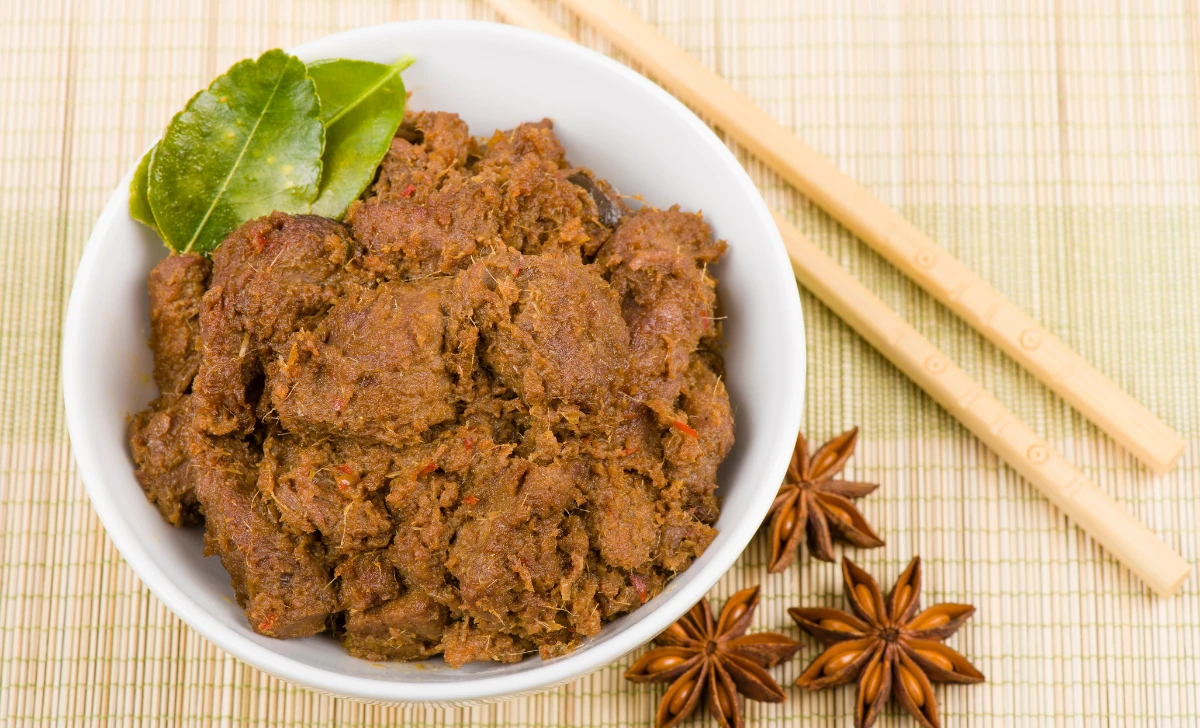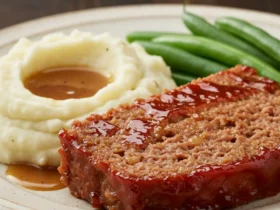Are you craving a hearty and aromatic dish that will tantalize your taste buds? Look no further than the famous Beef Rendang recipe from Indonesia. This traditional Indonesian dish is renowned for its rich and complex flavors, tender meat, and fragrant spices. In this article, we will take you on a culinary journey and provide you with a step-by-step guide to creating a delicious Beef Rendang in your own kitchen.
[ez-toc]
History
The history of the Beef Rendang recipe is deeply rooted in the culinary traditions of Indonesia, specifically among the Minangkabau ethnic group of West Sumatra. This dish has a rich history that spans centuries and holds cultural significance in the region.
The origins of Beef Rendang can be traced back to the Minangkabau people, who have a strong culinary heritage and are known for their flavorful dishes. The Minangkabau are indigenous to the highlands of West Sumatra, an area renowned for its agricultural abundance and fertile lands.
Beef Rendang was traditionally prepared for special occasions and celebrations, such as weddings, religious ceremonies, and festivals. The dish was often served as part of a lavish spread, showcasing the culinary prowess and hospitality of the Minangkabau people.
The slow-cooking technique used in Beef Rendang was developed out of necessity in the past. The dish was originally prepared by simmering tough cuts of beef for an extended period to tenderize the meat and infuse it with the flavors of various spices and herbs. This slow cooking process not only transformed the texture of the beef but also allowed the flavors to meld together, creating a rich and aromatic dish.
Over time, Beef Rendang gained popularity beyond the Minangkabau community and spread to other regions of Indonesia and even internationally. It has become one of the most iconic Indonesian dishes, representing the diverse culinary heritage of the country.
Today, Beef Rendang is enjoyed by people from all walks of life. It can be found in Indonesian restaurants worldwide, where chefs and home cooks alike strive to recreate the authentic flavors of this beloved dish. While the recipe may have evolved and adapted over time, the essence of Beef Rendang remains true to its roots—a flavorful, slow-cooked curry-like dish that captures the essence of Indonesian cuisine.
The history of Beef Rendang serves as a testament to the rich cultural heritage and culinary traditions of Indonesia. It continues to be a source of pride for the Minangkabau people and a beloved dish that brings people together to savor its tantalizing flavors and experience a taste of Indonesian culture.
Time
| Step | Time |
|---|---|
| Preparation (chopping ingredients, etc.) | 15 minutes |
| Cooking the beef and spices | 10 minutes |
| Adding coconut milk and simmering | 3 hours |
| Checking tenderness and sauce consistency | 5 minutes |
| Total Cooking Time | Approximately 3 hours and 30 minutes |
Please note that the cooking and preparation times provided are approximate and may vary depending on factors such as the heat intensity and the desired tenderness of the beef. It’s essential to monitor the cooking process closely to ensure the beef is tender and the sauce has reached the desired consistency.
Ingredients
| Ingredients | Quantity |
|---|---|
| Beef (preferably chuck roast), cut into cubes | 2 pounds (900 grams) |
| Coconut milk | 2 cans (800 ml) |
| Shallots | 4 |
| Garlic | 4 cloves |
| Lemongrass stalks | 2 |
| Kaffir lime leaves | 4 |
| Tamarind paste | 2 tablespoons |
| Palm sugar | 2 tablespoons |
| Vegetable oil | 2 tablespoons |
| Salt | To taste |
Please note that the quantities provided are for a serving size of 2 people. You may adjust the quantities accordingly based on your desired portion sizes and preferences.
Directions
1. Preparation
a. Finely chop the shallots and mince the garlic.
Prepare the ingredients by finely chopping the shallots and mincing the garlic. This will enhance the flavors and ensure even distribution throughout the dish.
b. Bruise the lemongrass stalks.
Lightly crush the lemongrass stalks with the back of a knife to release their aromatic oils.
c. Cut the kaffir lime leaves into thin strips.
Slice the kaffir lime leaves into thin strips to incorporate their citrusy fragrance into the dish.
d. Cut the beef into bite-sized cubes.
Trim and cut the beef into bite-sized cubes, ensuring even cooking and a satisfying texture.
2. Cooking Process
a. Heat the vegetable oil in a large, deep pan over medium heat.
Place a large, deep pan over medium heat and add the vegetable oil. Allow it to heat up before proceeding to the next step.
b. Add the chopped shallots and minced garlic to the pan.
Sauté the shallots and garlic in the heated oil until they turn fragrant and golden brown, infusing the oil with their flavors.
c. Add the beef cubes to the pan and cook until browned on all sides.
Add the beef cubes to the pan and cook them until they are evenly browned on all sides, sealing in the juices and enhancing the overall taste.
d. Pour in the coconut milk and stir well.
Add the coconut milk to the pan with the beef, stirring it well to combine. The creamy coconut milk will provide a luscious base for the dish.
e. Add the bruised lemongrass stalks, kaffir lime leaves, tamarind paste, and palm sugar to the pan.
Introduce the bruised lemongrass stalks, kaffir lime leaves, tamarind paste, and palm sugar to the pan, infusing the dish with their unique flavors.
f. Season with salt to taste and stir everything together.
Add salt according to your taste preferences and stir all the ingredients in the pan, ensuring they are well incorporated.
g. Reduce the heat to low and let the dish simmer uncovered for about 3 to 4 hours.
Lower the heat to a gentle simmer and let the dish cook uncovered for approximately 3 to 4 hours. This slow cooking process allows the flavors to meld and intensify while tenderizing the beef.
h. Stir occasionally to prevent sticking.
Stir the dish occasionally during the simmering process to prevent it from sticking to the pan and ensure even cooking.
i. Check the tenderness of the beef and sauce consistency.
After the simmering time, check the tenderness of the beef. It should be tender and easily break apart. Also, check the consistency of the sauce, which should be thick and rich.
j. Remove the lemongrass stalks and kaffir lime leaves.
Once the desired tenderness and sauce consistency are achieved, remove the lemongrass stalks and kaffir lime leaves from the dish. These were used to infuse the flavors and are not typically consumed.
3. Serving Suggestions
Serve the delicious Beef Rendang hot with steamed white rice or coconut rice. Garnish with fresh cilantro leaves, if desired. Enjoy the delightful combination of tender beef, flavorful sauce, and aromatic spices!
Please note that cooking times may vary, and it is important to adjust the heat level and cooking duration to achieve the desired tenderness and flavor profile for your Beef Rendang.
Equipment Required
Nutrition Information
| Nutrition Information | Amount Per Serving |
|---|---|
| Serving Size | 1 person |
| Calories | 450 |
| Total Fat | 32g |
| – Saturated Fat | 20g |
| Cholesterol | 85mg |
| Sodium | 450mg |
| Total Carbohydrate | 8g |
| – Dietary Fiber | 2g |
| – Sugars | 3g |
| Protein | 32g |
Please note that the nutrition information provided is an estimate and may vary depending on specific ingredients used and any variations or modifications made to the recipe. It’s always advisable to calculate the nutrition information based on the specific brands and quantities of ingredients you use in your preparation.
Tips
- Choose the right cut of beef: Opt for chuck roast or other cuts with marbling as they tend to be more tender and flavorful when slow-cooked.
- Slow cooking is key: The slow cooking process allows the flavors to develop and intensify. Be patient and let the dish simmer over low heat for several hours to achieve the best results.
- Adjust the spiciness: If you prefer a milder version, reduce the amount of chili peppers used. Conversely, if you enjoy spicier dishes, add more chili peppers or include some bird’s eye chili for an extra kick.
- Experiment with additional spices: While the traditional recipe includes a specific set of spices, you can personalize the dish by adding other aromatic spices like cinnamon, star anise, or cardamom for a unique twist.
- Pressure cooker option: If you’re short on time, you can use a pressure cooker to expedite the cooking process. However, note that the flavors may not develop as deeply as with the slow-cooking method.
- Make-ahead and reheating: Beef Rendang tastes even better the next day as the flavors continue to meld together. Prepare it ahead of time and reheat gently before serving for enhanced taste.
- Storage and freezing: Beef Rendang freezes well, so you can make a larger batch and store it in the freezer for later consumption. Use airtight containers or freezer bags, and consume within three months for the best flavor.
- Garnish with fresh herbs: For added freshness and visual appeal, garnish your Beef Rendang with chopped fresh cilantro or Thai basil leaves before serving.
Pros & Cons
| Pros | Cons |
|---|---|
| ✅ Rich and flavorful taste | ❌ Lengthy cooking time |
| ✅ Tender and succulent beef | ❌ Requires various spices and ingredients |
| ✅ Aromatic and fragrant | ❌ Can be spicy for some palates |
| ✅ Versatile and customizable | ❌ High in saturated fat |
| ✅ Showcases Indonesian culinary heritage | ❌ Not suitable for vegetarian or vegan diets |
Conclusion
In conclusion, Beef Rendang is a culinary masterpiece that brings together the rich flavors of Indonesian cuisine. With its tender and succulent beef, aromatic spices, and creamy coconut milk, this dish offers a delightful explosion of taste in every bite. The slow cooking process allows the flavors to develop and intensify, resulting in a truly satisfying culinary experience.
By following the step-by-step guide provided, you can recreate the authentic taste of Beef Rendang in your own kitchen. The recipe allows for customization, enabling you to adjust the spiciness and experiment with additional spices to suit your preferences. Whether you’re a meat lover or an adventurous food enthusiast, Beef Rendang offers a delightful journey into the vibrant flavors of Indonesian cuisine.
Indulge in the rich and complex flavors, and experience the culinary heritage of Indonesia with every mouthful. Gather your ingredients, follow the instructions closely, and be prepared to savor a dish that will impress your family and friends. The hearty and aromatic Beef Rendang is a perfect addition to your dining table, providing a truly satisfying and memorable meal.
So, don’t hesitate—venture into the world of Indonesian cuisine and embark on a flavorful journey with Beef Rendang. It’s time to tantalize your taste buds and discover the magic of this traditional dish. Get ready to enjoy a taste of Indonesia right in your own home!
Facts
- 🌶️ Spicy Powerhouse
- Did you know that Beef Rendang holds the title for being one of the spiciest dishes in the world? Its fiery heat is not for the faint of heart, making it a thrilling culinary adventure for spice enthusiasts.
- 🏆 UNESCO’s Intangible Cultural Heritage
- In 2011, Beef Rendang was officially recognized as an Intangible Cultural Heritage of Humanity by UNESCO. This prestigious recognition highlights the cultural significance and culinary excellence of this beloved Indonesian dish.
- ⏳ Slowest Cooking Recipe
- Beef Rendang holds the record for the slowest cooking recipe, with a traditional cooking time ranging from 3 to 4 hours. This extended cooking process allows the flavors to develop and creates melt-in-your-mouth tender meat.
- 🌴 Originating from the Land of Minang
- Beef Rendang originated from the Minangkabau people of West Sumatra, Indonesia. The Minangkabau are renowned for their exceptional culinary skills, and Beef Rendang is a proud representation of their rich culinary heritage.
- 🎉 Festive Delicacy
- Beef Rendang is not just an everyday dish—it’s often served during special occasions and celebrations in Indonesia. Whether it’s a wedding, Eid al-Fitr, or a family gathering, Beef Rendang adds a touch of festivity and deliciousness to the table.
FAQ’s
Can I use other types of meat instead of beef?
While beef is the traditional choice for Beef Rendang, you can experiment with other meats like chicken or lamb. However, keep in mind that the cooking times may vary.
Is Beef Rendang a spicy dish?
Yes, Beef Rendang is known for its spiciness. However, you can adjust the level of heat by reducing or increasing the amount of chili peppers used.
Can I make Beef Rendang ahead of time?
Absolutely! In fact, Beef Rendang tastes even better the next day as the flavors continue to meld together. Simply reheat gently before serving.
Can I freeze Beef Rendang?
Yes, Beef Rendang freezes well. Store it in an airtight container or freezer bag and consume it within three months for the best flavor.
Can I use store-bought rendang spice paste instead of making it from scratch?
Yes, you can use store-bought rendang spice paste as a time-saving alternative. However, making the spice paste from scratch allows for more control over the flavors and ingredients used.
What can I serve with Beef Rendang?
Beef Rendang is traditionally served with steamed white rice or coconut rice. You can also pair it with a fresh cucumber salad or pickled vegetables for a balanced meal.
How do I make Beef Rendang less spicy?
To make Beef Rendang less spicy, reduce the amount of chili peppers used or remove the seeds and membranes, which contain most of the heat. You can also balance the spiciness with coconut milk or serve it with plain yogurt or raita on the side.
Can I make Beef Rendang in a slow cooker?
Yes, you can adapt the recipe for a slow cooker. Brown the beef and sauté the shallots and garlic first, then transfer everything to the slow cooker along with the remaining ingredients. Cook on low for 6-8 hours or on high for 3-4 hours until the beef is tender.
How long does it take to cook Beef Rendang on the stovetop?
Beef Rendang typically takes around 3 to 4 hours to cook on the stovetop over low heat. This slow cooking process allows the flavors to develop and the meat to become tender.
Can I make a vegetarian version of Rendang?
Yes, you can make a vegetarian version of Rendang by substituting the meat with tofu, tempeh, or a variety of vegetables like jackfruit or mushrooms. Adjust the cooking time and seasonings accordingly for a delicious vegetarian rendition of this flavorful dish.












Leave a Review